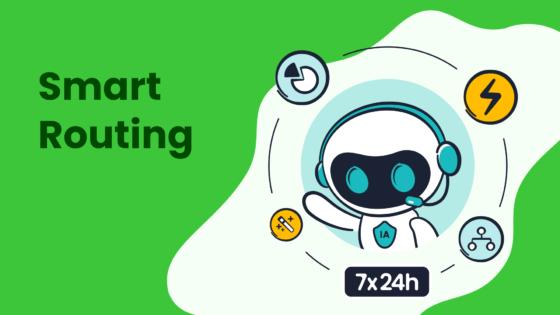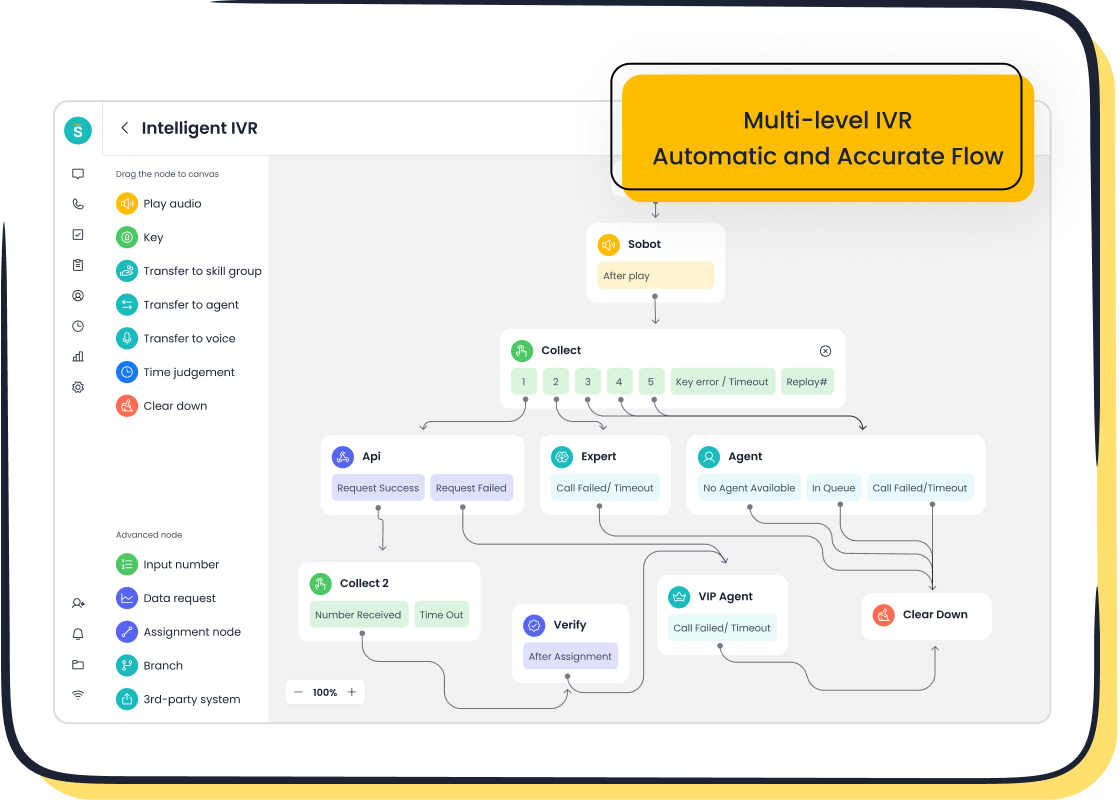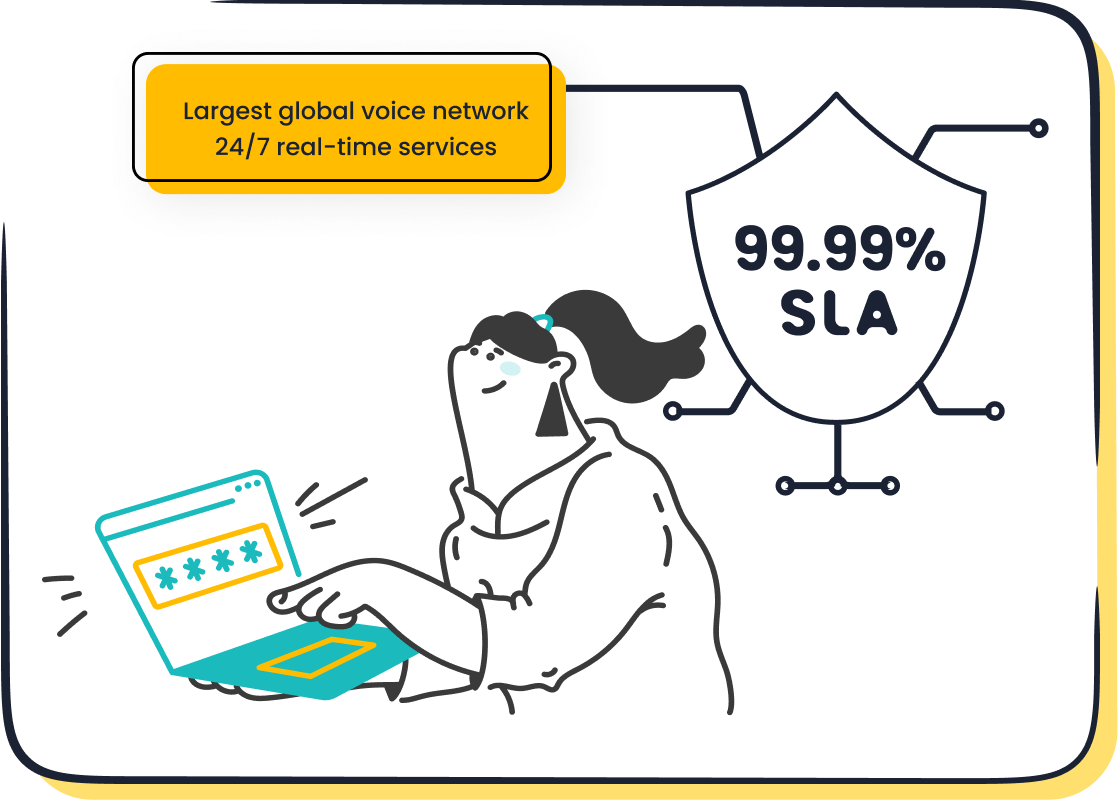How Speech Recognition is Driving Industry Innovation in 2025

Speech recognition is reshaping how you interact with technology in 2025. Its adoption has surged across industries, with customer service leading at 81% and sales at 52%. This growth reflects its ability to enhance communication and streamline operations. For example, AI-driven multilingual support now enables healthcare providers to assist patients in their native languages, improving satisfaction and accessibility.
Sobot’s Voice/Call Center showcases how businesses can harness this technology. With features like AI-powered voicebots and smart call routing, it helps you deliver efficient, personalized customer experiences. As the global market for speech recognition grows toward $25 billion, its transformative impact becomes undeniable.
Understanding Speech Recognition Technology
What is Speech Recognition?
Definition and core components
Speech recognition refers to the ability of machines to identify and process human speech into text. It relies on several core components to function effectively. These include a speech input system, feature extraction tools, and a decoder. The decoder uses acoustic models, a pronunciation dictionary, and language models to produce accurate word outputs. Together, these components enable the transformation of spoken words into digital text, forming the foundation of speech recognition technology.
How it works: From speech to text

The process begins when sound vibrations from your voice are converted into electrical signals. These signals are then digitized and analyzed. Advanced algorithms match the digital signals with corresponding text representations. For example, natural language processing (NLP) helps the system understand the context of your speech, ensuring accurate transcription. This speech-to-text process powers applications like virtual assistants, transcription tools, and Sobot’s Voice/Call Center, which uses AI-powered voicebots to enhance customer interactions.
Key Technologies Behind Speech Recognition
Role of AI and machine learning

AI and machine learning play a pivotal role in modern speech recognition. Machine learning models, such as neural networks and Hidden Markov Models (HMM), analyze vast datasets to improve accuracy. These technologies enable systems to recognize diverse accents, dialects, and speech patterns. For instance, Sobot’s voice recognition solutions leverage AI to provide intelligent call routing and real-time transcription, ensuring seamless communication for businesses worldwide.
Natural language processing (NLP) and its importance
NLP enhances speech recognition by understanding the context and intent behind spoken words. It allows systems to infer user goals, clarify ambiguities, and deliver personalized responses. For example, NLP can detect emotions in customer queries, enabling empathetic interactions. This capability is crucial in industries like customer service, where tools like Sobot’s Voice/Call Center use NLP to improve customer satisfaction and operational efficiency.
Standards and Benchmarks in the Speech and Voice Recognition Market
Accuracy rates and performance metrics
The speech and voice recognition market measures accuracy using metrics like Word Error Rate (WER). State-of-the-art systems achieve WERs below 5% on high-quality audio datasets. However, factors like background noise and speaker diversity can impact performance. For example, test sets like Librispeech and CallHome show up to a 10% difference in WER due to varying conditions. Businesses rely on these benchmarks to evaluate the effectiveness of automatic speech recognition systems.
Industry-wide adoption of multilingual support
Multilingual support has become a standard in the speech and voice recognition market. Systems now handle multiple languages and seamlessly switch between them. This capability is essential for global businesses. For instance, Sobot’s Voice/Call Center offers multilingual templates, enabling companies like Weee! to serve diverse customer bases efficiently. This feature highlights the transformation of speech recognition into a truly global tool.
Key Innovations in Speech Recognition in 2025
AI-Driven Accuracy and Contextual Understanding
Improved recognition of accents and dialects
Speech recognition systems in 2025 excel at understanding diverse accents and dialects. AI models now adapt to regional speech patterns, ensuring accurate transcription regardless of the speaker's background. Self-learning algorithms refine their ability to differentiate between homophones and recognize domain-specific terminology. For example, Sobot’s Voice/Call Center leverages these advancements to provide seamless communication for businesses operating in multilingual environments. This innovation ensures that your customers feel understood, no matter where they are from.
Context-aware transcription for better accuracy
AI-powered transcription has reached new heights with contextual understanding. Modern systems analyze the setting and subject matter of conversations to adjust their responses. For instance, if you discuss medical topics, the system prioritizes healthcare-related terms for accuracy. This capability enhances applications like customer service, where tools such as Sobot’s Voice/Call Center use context-aware transcription to improve call routing and resolution rates. These advancements make speech recognition more reliable and user-friendly.
Real-Time Transcription and Translation
Applications in global communication
Real-time transcription and translation bridge language gaps, enabling effective communication across the globe. These tools empower individuals with hearing impairments or language barriers to participate in conversations. Businesses also benefit by enhancing productivity during meetings, as participants can follow discussions and take notes effortlessly. For example, Sobot’s multilingual templates allow companies like Weee! to serve diverse customer bases efficiently. This technology transforms how you interact in multilingual settings, fostering inclusivity and collaboration.
Benefits for remote work and collaboration
Remote work thrives on clear communication, and real-time transcription plays a vital role. It ensures that team members from different regions can collaborate without language barriers. Features like live translations and accurate transcriptions enhance virtual meetings, making them more productive. Sobot’s AI-powered transcription tools streamline these processes, helping you focus on meaningful discussions rather than logistical challenges. This innovation supports the growing demand for flexible and efficient remote work solutions.
Multilingual and Cross-Device Integration
Seamless switching between languages
Multilingual speech recognition has become a cornerstone of global business operations. AI advancements now allow systems to switch between languages effortlessly, catering to diverse audiences. Companies strive to support over 50 languages, ensuring accessibility for users worldwide. Sobot’s Voice/Call Center exemplifies this trend by offering multilingual templates and intelligent routing. These features enable you to deliver personalized experiences, regardless of your customers’ linguistic preferences.
Integration with IoT and smart devices
Speech recognition integrates seamlessly with IoT and smart devices, enhancing convenience and accessibility. Voice technology enables hands-free control of your environment, allowing you to manage tasks efficiently. For instance, you can monitor and control devices remotely using voice commands. Sobot’s solutions align with this trend, offering secure and scalable systems that support voice-activated interactions. This integration transforms how you interact with technology, making daily life more streamlined and intuitive.
Transformative Applications of Speech Recognition in Customer Service
Enhancing Call Centers with Sobot's Voice/Call Center
AI-powered voicebots for efficient customer interactions
AI-powered voicebots have revolutionized how you interact with call centers. These bots handle routine inquiries, freeing agents to focus on complex issues. For example, Sobot’s Voice/Call Center uses AI to recognize customer intent and provide instant responses. This reduces wait times and improves satisfaction. With multilingual support, these voicebots cater to diverse audiences, ensuring seamless communication. Businesses using speech recognition solutions report measurable benefits, such as shorter call durations and higher first-call resolution rates.
Smart call routing and real-time transcription
Smart call routing ensures your call reaches the right agent quickly. Sobot’s Voice/Call Center uses AI to analyze customer needs and route calls based on expertise, improving resolution rates. Real-time transcription enhances this process by converting speech-to-text instantly, allowing agents to focus on solving problems rather than taking notes. These features not only boost operational efficiency but also enhance customer satisfaction, as seen in companies like Weee!, which achieved a 96% satisfaction score after implementing Sobot’s solutions.
Speech Recognition in Healthcare
Voice-enabled patient records and diagnostics
Speech recognition in healthcare has streamlined how clinicians manage patient data. Medical speech recognition software transcribes notes and integrates them into electronic health records, saving time and reducing errors. This technology improves health records management by creating accurate, comprehensive plans. For example, clinicians can dictate diagnoses or treatment plans, allowing more time for patient engagement. Studies show that healthcare IT solutions using speech recognition enhance productivity by 10%, benefiting both patients and providers.
Enhancing telemedicine with real-time transcription
Telemedicine relies on clear communication, and speech recognition plays a vital role. Real-time transcription records patient comments and medical histories during virtual consultations. This ensures accurate appointment transcription and improves consistency in medical data. Sobot’s multilingual support further enhances telemedicine by breaking language barriers, enabling you to receive care in your preferred language. These advancements make healthcare more accessible and efficient, especially in remote areas.
Automotive and Smart Homes
Voice-activated controls for safer driving
Speech recognition enhances automotive safety by enabling hands-free controls. Features like multi-speaker isolation and background noise elimination ensure accurate command recognition, even in noisy environments. This allows you to adjust navigation, make calls, or control music without taking your hands off the wheel. These advancements reduce distractions and improve road safety, making driving more secure and convenient.
Integration with home automation systems
In smart homes, speech recognition provides a hands-free solution for managing devices. You can lock doors, adjust lighting, or monitor security cameras using voice commands. This technology enhances security by restricting access to authorized users. Sobot’s solutions align with these trends, offering scalable systems that integrate seamlessly with IoT devices. These applications transform your home into a more intuitive and secure environment, simplifying daily tasks.
Challenges and Solutions in Speech Recognition
Privacy and Data Security
Concerns over data collection and storage
Speech recognition systems often process and store voice data in the cloud, raising significant privacy concerns. Risks include:
- Unauthorized access to cloud-stored voice data.
- Misuse of data by companies for purposes beyond user consent.
- Vulnerability of biometric data, such as voiceprints, to hacking.
- Improper recording or analysis of voice data, potentially violating privacy laws.
These issues highlight the importance of safeguarding user data in speech recognition applications, especially as businesses increasingly rely on cloud-based solutions.
Solutions: Encryption and user consent

To address these concerns, companies implement robust encryption protocols to secure voice data during transmission and storage. For example, Sobot’s Voice/Call Center ensures encrypted data transfer, protecting sensitive customer information. Additionally, obtaining explicit user consent before data collection fosters transparency and trust. By prioritizing these measures, you can confidently adopt speech recognition technology without compromising privacy.
Accuracy in Complex Environments
Challenges with background noise and overlapping speech
Real-world environments often present challenges like background noise, cross-talk, and white noise. These factors interfere with the accuracy of speech recognition systems, making it difficult to capture clear audio input. For instance, a busy call center or a crowded public space can significantly hinder transcription quality.
Solutions: Advanced noise-canceling algorithms
Advanced noise-canceling algorithms, such as spectral subtraction and Wiener filtering, improve the signal-to-noise ratio, enhancing speech clarity. Sobot’s AI-powered voicebots leverage these techniques to deliver accurate transcriptions, even in noisy settings. Additionally, training models with real-world noise profiles helps systems adapt to challenging environments. These innovations ensure reliable performance, whether you’re managing customer calls or using voice commands in a bustling office.
Implementation Costs and Accessibility
High costs for small businesses
Small businesses often face high upfront costs when adopting speech recognition technology. Expenses include software licenses, hardware upgrades, and employee training. These barriers can make it difficult for smaller organizations to compete with larger enterprises in the speech recognition space.
Solutions: Cloud-based and subscription models

Cloud-based solutions offer a cost-effective alternative for small businesses. Subscription models eliminate the need for expensive hardware, allowing you to pay only for what you use. For example, Sobot’s Voice/Call Center operates on a SaaS rental model, providing scalable and affordable access to advanced speech recognition features. By assessing your business needs and choosing flexible software, you can implement this technology without straining your budget.
The Future of Speech Recognition
Emotional Intelligence in Speech Recognition
Detecting emotions through tone and context
Speech recognition systems are evolving to detect emotions by analyzing tone, pitch, and context. These advancements allow machines to interpret not just what you say but how you feel. For example, AI models can identify stress or frustration in a customer’s voice during a call. This capability enables businesses to respond empathetically, improving customer satisfaction. In healthcare, emotion detection helps clinicians assess mental health conditions by analyzing speech patterns. These innovations make speech recognition more human-like, enhancing its role in emotional and contextual understanding.
Applications in mental health and customer service

Emotion-aware speech recognition is transforming mental health care. It supports therapists by identifying signs of anxiety or depression in patients’ speech. In customer service, tools like Sobot’s Voice/Call Center use emotion detection to prioritize urgent calls or escalate issues to supervisors. This ensures timely and effective responses, creating a better experience for both customers and agents. By integrating emotional intelligence, speech recognition is becoming a vital tool in industries that require empathy and precision.
Deeper Integration Across Devices
Unified ecosystems for seamless user experiences
The future of speech recognition lies in its ability to unify devices into a seamless ecosystem. Imagine controlling your smart home, car, and office tools with a single voice command. This integration enhances convenience and productivity. For instance, Sobot’s solutions already support cross-device compatibility, enabling you to manage customer interactions from any platform. As ecosystems become more interconnected, speech recognition will redefine how you interact with technology, making daily tasks more intuitive.
Anticipated role in the metaverse and AR/VR
Speech recognition is set to play a pivotal role in the metaverse and AR/VR environments. Voice commands will allow you to navigate virtual spaces, interact with digital avatars, and perform tasks hands-free. AI-powered systems will adapt to your preferences, creating personalized experiences. For businesses, this opens new opportunities for customer engagement. Sobot’s scalable and secure platforms align with these trends, ensuring you stay ahead in a rapidly evolving digital landscape.
Expanding Industry Applications
Potential in education and training
Speech recognition is revolutionizing education by enabling hands-free, interactive learning. It supports language acquisition through pronunciation practice and real-time feedback. Students with disabilities benefit from improved accessibility, such as voice-to-text tools for note-taking. Automated grading of verbal assignments reduces educators’ workload while maintaining consistency. These applications make learning more inclusive and efficient, preparing you for a future where technology enhances education at every level.
Opportunities in entertainment and media
The entertainment industry is leveraging speech recognition to meet growing consumer demand for cloud-based tools. Real-time transcription enhances accessibility for live events and broadcasts. Multilingual support allows global audiences to enjoy content in their preferred language. For example, AI-powered automation streamlines operations in media production, saving time and resources. As speech recognition integrates across devices, it creates immersive experiences for both creators and consumers, shaping the future of entertainment.
Speech recognition continues to transform industries in 2025 by improving communication and operational efficiency. You see its impact in tools like Sobot's Voice/Call Center, which uses AI-powered voicebots and smart call routing to enhance customer interactions. Businesses like Weee! have already achieved measurable success, including a 96% satisfaction score, by adopting these solutions.
The future of speech recognition looks even brighter. Trends like emotional intelligence and cross-device integration promise to revolutionize how you interact with technology. As this innovation evolves, it will redefine user experiences across healthcare, customer service, and beyond.
FAQ
What industries benefit the most from speech recognition in 2025?
Speech recognition transforms industries like customer service, healthcare, and education. For example, Sobot’s Voice/Call Center helps businesses improve customer satisfaction with AI-powered voicebots and multilingual support. In healthcare, real-time transcription enhances telemedicine. These innovations make communication more efficient across diverse sectors.
How does Sobot ensure data security in its Voice/Call Center?
Sobot prioritizes data security with encrypted data transfer and storage. Its Voice/Call Center complies with global privacy standards, ensuring your sensitive information remains protected. This approach builds trust and safeguards your business operations.
Can small businesses afford speech recognition technology?
Yes, cloud-based solutions like Sobot’s Voice/Call Center offer affordable subscription models. These eliminate high upfront costs, making advanced speech recognition accessible to small businesses. You can scale features based on your needs, ensuring cost-effectiveness.
How does multilingual support improve customer service?
Multilingual support allows businesses to serve diverse audiences effectively. Sobot’s Voice/Call Center offers templates in multiple languages, enabling seamless communication. For example, Weee! achieved a 96% satisfaction score by using Sobot’s multilingual features to address language barriers.
What makes Sobot’s Voice/Call Center unique?
Sobot’s Voice/Call Center combines AI-powered voicebots, smart call routing, and real-time transcription. It ensures 99.99% uptime and integrates seamlessly with existing systems. These features enhance customer interactions and operational efficiency, making it a reliable choice for businesses worldwide.
See Also
Best 10 Speech Analysis Tools for Call Centers in 2024
Leading 10 Customer Feedback Software Options for 2024
Best Reviewed Automated Voice Calling Software for 2024
Best 10 IVR Solutions for Interactive Voice Response in 2024
Understanding the Functionality of IVR Voice Recognition Software
